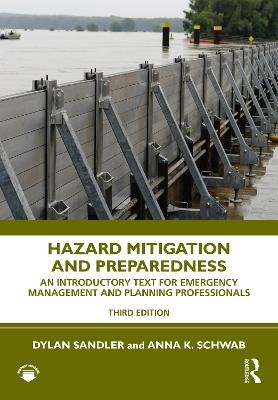
Hazard Mitigation and Preparedness
Routledge (Verlag)
978-0-367-63577-0 (ISBN)
This new edition includes:
Updates to case studies and sidebars with recent disasters and mitigation efforts, including major hurricanes, wildfires, earthquakes, and the COVID-19 pandemic.
Summary of the National Flood Insurance Program, including how insurance rates are determined, descriptions of flood maps, and strategies for communities to help reduce premiums for residents.
Overview of the ways that climate change is affecting disasters and the tools that emergency managers can use to plan for an uncertain future.
Best practices in communication with the public, including models for effective use of social media, behavioral science techniques to communicate information about risk and preparedness actions, and ways to facilitate behavior change to increase the public’s level of preparedness.
Actionable information to help emergency managers and planners develop and implement plans, policies, and programs to reduce risk in their communities.
Updated in-text learning aids, including sidebars, case studies, goals and outcomes, key terms, summary questions and critical thinking exercises for students.
An eResource featuring new supplemental materials to assist instructors with course designs. Supplements include PowerPoint slides, tests, instructor lecture notes and learning objectives, key terms and a course syllabus.
Dylan Sandler serves as a Senior Planner at the New York City Department of City Planning. In this role, he manages citywide zoning changes and advises the City Planning Commission on land use policy. His areas of focus include hazard mitigation, climate adaptation, distributed energy production and battery storage, urban agriculture, industrial policy, and economic development. Following Hurricane Sandy, Mr. Sandler served as the project manager of the Resilient Industry Study, an initiative to help industrial businesses recover from damage caused by Hurricane Sandy and reduce risk during future events. He also serves as the agency’s liaison on the city’s Hazard Mitigation Plan. Previously, Mr. Sandler worked as a consultant supporting the National Oceanic and Atmospheric Administration to implement that National Climate Action Plan and the National Ocean Policy. In this role, Mr. Sandler facilitated communication and policy development across federal agencies focused on coastal planning and climate mitigation and adaptation. Mr. Sandler also served as a research associate at the Center for the Study of Natural Hazards and Disasters located at the University of North Carolina at Chapel Hill, where he conducted applied research regarding hazard mitigation, sea level rise adaptation and disaster recovery planning, and helped maintain the Center’s website and social media. Mr. Sandler has direct experience with hazard mitigation planning at the local and state level. Working with the North Carolina Division of Emergency Management, he reviewed local plans for state and federal compliance, authored a chapter on climate change for the North Carolina State Hazard Mitigation Plan, and helped compile materials used in training sessions for hazard mitigation planners. Anna K. Schwab is program manager at the US Department of Homeland Security Coastal Resilience Center of Excellence (CRC) administered at the University of North Carolina at Chapel Hill (UNC-CH). The Center focuses on conducting research associated with natural hazards and disasters, translating the findings to practice and educating the next generation of hazards scholars and practitioners. In her role as Program Manager, Ms. Schwab works collaboratively with diverse partners around the country to coordinate the research, education, and outreach projects of the Center, acts as liaison among participating principal investigators, and facilitates engagement of the CRC Advisory Board. Prior to her current position at the Resilience Center, Ms. Schwab served as project manager and research associate at the Hazard Mitigation Planning Initiative, a partnership between UNC-CH and the NC Division of Emergency Management which provided technical assistance to local governments for the development, adoption and implementation of local and regional hazard mitigation plans in compliance with the federal Disaster Mitigation Act. Ms. Schwab also spent many years serving as a research associate and program coordinator for a variety of public service and research initiatives at UNC-CH, with her primary focus concentrating on emergency management, natural hazards mitigation, land use, law and planning, environmental and emergency management ethics, coastal zone management, sustainable development, and natural resource conservation.
Chapter 1: Hazards and Disasters Chapter 2: Preparedness, Hazard Mitigation, and Climate Change Part 1 Introduction Chapter 3: Meteorological and Hydrological Hazards: Hurricanes, Sea Level Rise, Floods, Drought, Wildfire, Tornadoes, Severe Winter Weather, and Extreme Heat Chapter 4: Geological Hazards: Earthquakes, Tsunamis, Volcanoes, Landslides, Coastal Erosion, and Land Subsidence Chapter 5: Human-Made Hazards: Terrorism, Civil Unrest and Technological Hazards Part 2 Introduction Chapter 6: Role of the Federal Government in Disaster Management Chapter 7: Mitigating Hazards at the State Level Chapter 8: Local Government Powers: Building Resilience from the Ground Up Chapter 9: Community Resilience and the Private Sector Part 3 Introduction Chapter 10: Risk Assessment: Identifying Hazards and Vulnerability Chapter 11: Preparedness Activities: Planning to Be Ready When Disaster Hits Chapter 12: Hazard Mitigation Planning: Creating Strategies to Reduce Vulnerability Part 4 Introduction Chapter 13: Disaster Resilience: Living With Our Environment
| Erscheinungsdatum | 01.10.2021 |
|---|---|
| Zusatzinfo | 23 Tables, black and white; 3 Line drawings, black and white; 11 Halftones, black and white; 14 Illustrations, black and white |
| Verlagsort | London |
| Sprache | englisch |
| Maße | 178 x 254 mm |
| Gewicht | 2040 g |
| Themenwelt | Naturwissenschaften ► Biologie ► Ökologie / Naturschutz |
| Naturwissenschaften ► Geowissenschaften ► Geografie / Kartografie | |
| Naturwissenschaften ► Geowissenschaften ► Geologie | |
| Naturwissenschaften ► Geowissenschaften ► Geophysik | |
| Sozialwissenschaften ► Politik / Verwaltung ► Europäische / Internationale Politik | |
| ISBN-10 | 0-367-63577-1 / 0367635771 |
| ISBN-13 | 978-0-367-63577-0 / 9780367635770 |
| Zustand | Neuware |
| Haben Sie eine Frage zum Produkt? |
aus dem Bereich


